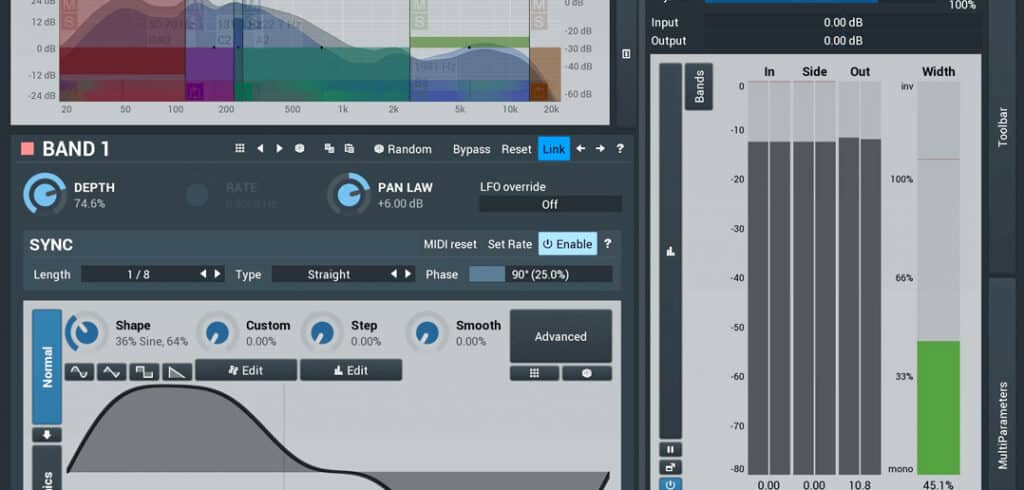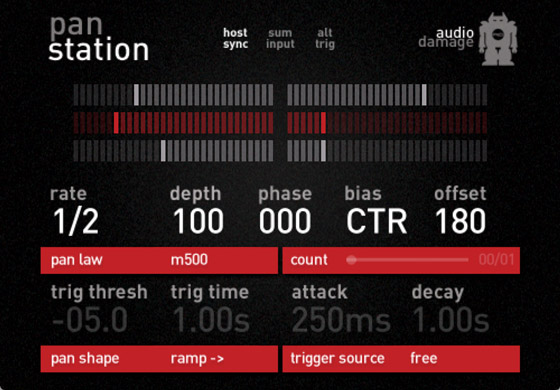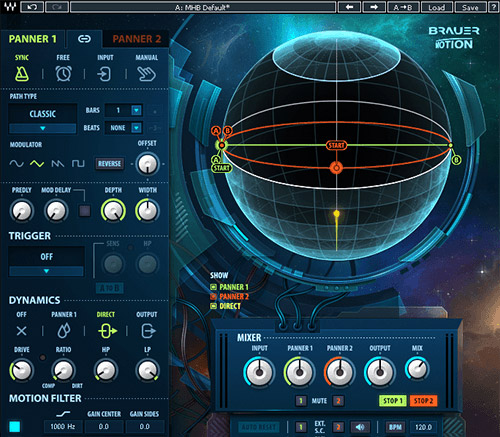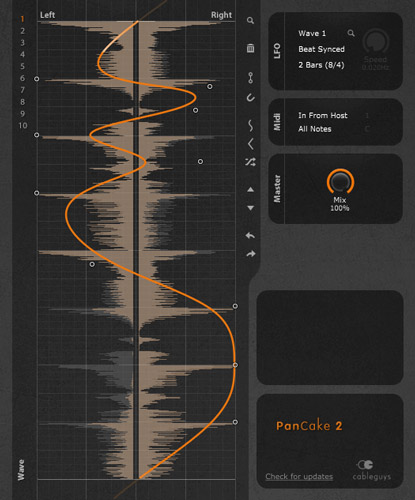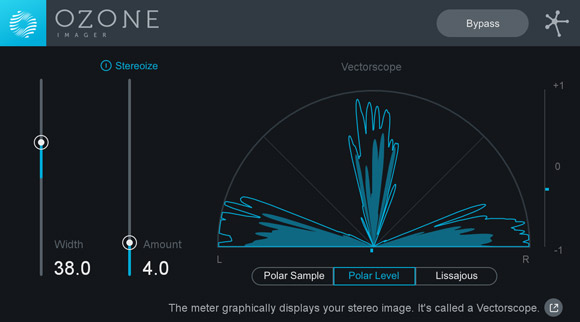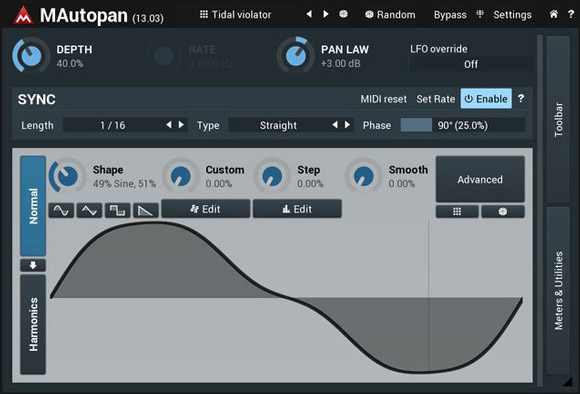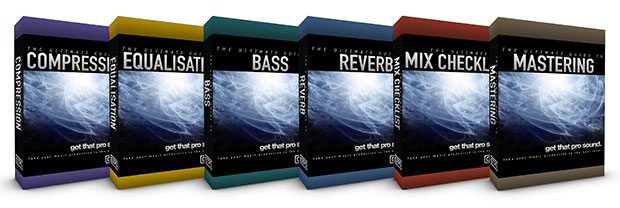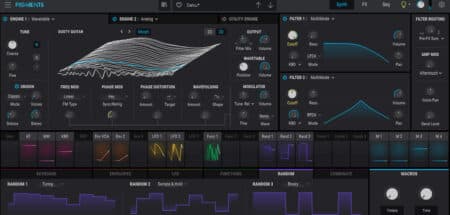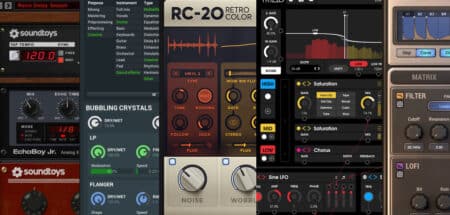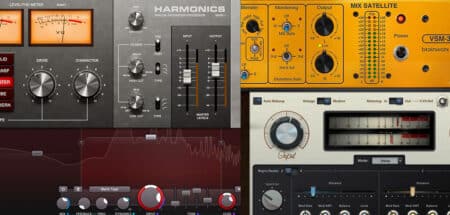Panning is generally thought of as a fairly dry and functional mixing tool, a way to achieve additional separation and clarity between different components in a full mix. But as with all technical tools and techniques in audio production, it has its creative uses and misuses too, which can be particularly helpful when approaching sound design projects.
Together with reverb, EQ and good old-fashioned signal levels, panning and stereo processing provide yet another dimensional plane — width — across which you can stretch, carefully position and sculpt your sounds.
Catch up on the other parts in the series:
- Part 1 – Delay
- Part 2 – Distortion
- Part 3 – Layering
- Part 4 – Classic Modulation FX
- Part 5 – Stereo & Panning FX
- Part 6 – Pitch Shifting
- Part 7 – Reverb
- Part 8 – Step Sequencers & Envelope Generators
- Part 9 – Creative Filtering
- Part 10 – Granular Synthesis & Sample Processing
Part 5: Stereo and Panning FX In Sound Design
Often The Best Solution Is Mono Sounds Panned Across A Stereo Field
Wider is not always necessarily better. As counterintuitive as it can first appear, you can actually get more clarity — and by extension, more scale and impact — by positioning individual mono channel sound elements and layers across the stereo field, rather than making or keeping every sound element in broad stereo in an effort to generate greater width. Think of it this way: If you try for width and spaciousness with every individual element in a sound effect or mix, they are all fighting evenly for sonic space across the whole stereo spectrum, and in the end, none of them have space or clarity.
Try instead to carefully position your sounds within the stereo spectrum in the same that you might use EQ and filters to have each sound occupy a particular frequency domain without too much messy overlap between them. If you’re starting with a stereo sound, sample, hit or layer, try discarding one of the stereo sides and working with the other side as a mono sound: it will be easier and clearer to position the sound exactly where you want it, in context. Of course, you can still pan these mono channel sound components hard left or right if you want, and of course combine them with true stereo sounds as well, achieving the best of both worlds. Just remember that a good balance between epically wide and highly directional, detailed sounds, often sounds best and most impactful and enveloping for the listener.
Auto-Panning For Movement
We’ve discussed the roles of automation and modulation a lot in this series so far, and moving sounds across the stereo field as they play out, either rhythmically or pseudo-randomly, can add a huge amount of life and dynamism to an otherwise static sound. In fact, when combining panning with other modulated parameters such as filter cutoffs, effect send amounts, and sample or loop start points, is when you can really generate some apparently ridiculously complicated- and sophisticated-sounding effects, great for complex slam hits, risers and droppers, evolving pads and synth lines, and almost anything else.

Of course you can automate pan modulation on a channel with your regular DAW automation functionality. Auto-panner plugins usually take the concept a little further with dedicated LFOs and a few additional controls, and streamline the ability to come up with more complex and easily editable modulations. Some of the best auto-pan plugins are based loosely on the vintage hardware unit, the ADR PanScan. More on that below.
Stereo Width
We already covered the Haas effect in the previous article on classic modulation FX. The Haas effect is the auditory phenomenon of a stereo sound appearing exceptionally wide when a carefully calibrated short delay is introduced to one of he two stereo channels.
Most stereo enhancers make use of the Haas effect principle under the hood, often combined with additional subtle processing to specific frequency ranges and other cool stuff to give you options for precisely tailoring and controlling the actual and perceived width and stereo positioning of your sounds.
An oft-repeated maxim when it comes to mixing is to keep bass and low-frequency elements mono/centered, and the higher the main frequency content of a sound, the more dramatically you can pan it to the sides without it losing energy and level. Now while this does make sense for most typical mix scenarios, don’t feel that you can never pan bass elements or that all your high-frequency elements have to be super-wide. Especially when working in a sound design and spot effects context, experiment with panning sounds outside their expected pan positions – and remember that these sounds very much do need to remain at a static position in the stereo field, automate and modulate away and you can come up with some really unique effects that can work amazingly with the right sonic source material.
The Doppler Effect
The Doppler effect is another acoustic phenomenon, which we all recognize in the common effect of a passing siren appearing to rise in pitch as it approaches and then descend again as it moves away from us. The effect is caused by the sound waves from the siren “bunching up” as it approaches, effectively shortening the perceived wavelength, and therefore, raising the pitch. As the sound begins to move away from us again, the reverse happens: the waves get more spread out, and the apparent pitch of the siren drops.
This is relevant to sound designers in a couple of ways. First, since you’re changing multiple parameters simultaneously (volume, pan and pitch) by independent (or relative) amounts, it’s simply another cool way to modulate a sound and create some really dynamic effects fairly quickly and easily. Leave them as is, or resample for further processing. Second, you can aim to invoke the psychological impact of the Doppler effect more literally, to make listeners feel like sound objects really are moving toward and away from them. This is especially good for buildup effects and risers (I think there’s a good reason why we mostly unconsciously associate a rising tone with excitement and energy: because we interpret it, on some level, as the sound moving towards us, it immediately grabs our attention as we’re instinctively wired to notice incoming potential threats and new objects in our immediate environment).
The Best Panning And Stereo Plugins For Sound Design: Roundup List
1) Soundtoys PanMan
Like most Soundtoys plugins, the design and feature set of PanMan has its roots in vintage hardware auto-panners such as the ADR PanScan we mentioned earlier.
PanMan takes advantage of all of the modulation tricks used in other Soundtoys plugins, such as the ability to design your own pan sweeps and patterns using the built-in Rhythm Step Editor, offset and smooth the timing to get your pans absolutely in whatever pocket you want, and even use the dynamics of the input signal to trigger pan effects.
It even features Soundtoys saturation circuit modelling, so you have the option of introducing some subtle colour to your signals even while you’re throwing them around the stereo field.
And remember that being part of the Soundtoys 5 bundle, PanMan is also one of the available modules in the Soundtoys Effect Rack plugin that comes with the bundle, allowing you to stack multiple effects inside a single plugin instance. Perfect for mixing panning effects with other modulation types, distortion and delays, for example.
Available for: Mac, PC | VST, AU, AAX
[button link=”https://www.pluginboutique.com/product/2-Effects/27-Stereo-Width/1806-PanMan” target=”_blank” preset=”blue” text_color=”#ffffff” color=”#238bcd”]BUY NOW[/button] via Plugin Boutique.
2) Audio Damage Panstation
Very full-featured, Panstation centers around a pair of flexible LFOs that, together with the well-laid-out Rate, Depth, Phase, Bias, Offset and Trigger Threshold features, provide just about any panning (or tremolo, or gating) effects you might need or want.
With five different panning laws and 12 LFO shapes to choose from, plus the ability to use incoming audio or MIDI signals for triggering the pan effect, this one is up there as a contender for best all-round panning plugin.
Available for: Mac, PC | VST, AU, AAX
[button link=”https://www.audiodamage.com/products/ad028-panstation” target=”_blank” preset=”blue” text_color=”#ffffff” color=”#238bcd”]DOWNLOAD[/button] via Audio Damage.
3) Waves Brauer Motion
Grammy-winning mix engineer Michael Brauer’s collaboration with Waves led to Brauer Motion, a one-of-a-kind plugin that features dual panner modules, a Dynamics section, and a built-in filter for getting meticulously detailed and sophisticated panning and spatial effects all from within the single, relatively streamlined and easy to navigate interface.
I’ll let the man himself tell you more – and demonstrate – exactly what it can do:
<iframe width=”560″ height=”315″ src=”https://www.youtube.com/embed/0k6Vfxdj6V8″ frameborder=”0″ allow=”accelerometer; autoplay; encrypted-media; gyroscope; picture-in-picture” allowfullscreen></iframe>
Available for: Mac, PC | VST, AU, AAX
[button link=”https://waves.alzt.net/YYP4j” target=”_blank” preset=”blue” text_color=”#ffffff” color=”#238bcd”]BUY NOW[/button] via Waves.
4) Waves Doppler, S1 Stereo Imager/Shuffler and More
Waves’ Doppler was one of the first spatial effects that we fell in love with. The fun to be had with this one is endless, and while it may literally seem like a one-trick pony, you’d be surprised how many more subtle applications you find for adding some interesting movement and “quick ‘n’ weird” modulation to sounds and effects.
There are a lot of Waves plugins in general, and there is a good range of stereo and panning-related ones too that range from straightforward utilities to more out-there modulation effects. For the former, check out Center, and the PS22 Stereo Maker; for the latter, the Infected Mushroom Pusher plugin’s “secret sauce” processing includes a pan control amongst its feature set.
Maybe the GUIs are a little “Windows 95” by todays standards, but the quality and features of these plugins are all that really matters – in fact, the simple no-nonsense graphics make it easier to quickly dial in exactly the settings that are going to work for your application with the minimum of fuss. Check out this primer on using the S1 Stereo Imager for more on how this works and how it can improve your sounds and mixes:
<iframe width=”560″ height=”315″ src=”https://www.youtube.com/embed/ZRT70qx0vqA” frameborder=”0″ allow=”accelerometer; autoplay; encrypted-media; gyroscope; picture-in-picture” allowfullscreen></iframe>
Available for: Mac, PC | VST, AU, AAX
[button link=”https://waves.alzt.net/azVYM” target=”_blank” preset=”blue” text_color=”#ffffff” color=”#238bcd”]BUY NOW[/button] via Waves.
6) Cableguys PanCake 2
Not for those who like their panning “middle of the road” (no pun intended), Pancake 2 can get pretty wild pretty quickly. Perfect for sound designers on a budget: it’s also a free download! Just hit the button below.
Available for: Mac, PC | VST, AU, AAX
[button link=”https://www.pluginboutique.com/product/2-Effects/33-Modulator/564-PanCake-2″ target=”_blank” preset=”blue” text_color=”#ffffff” color=”#238bcd”]DOWNLOAD[/button] via Plugin Boutique.
7) iZotope Ozone Imager
Another free plugin, iZotope’s Ozone Imager is pulled from their flagship Ozone 8 mixing and mastering plugin software. With its simple controls and the vectorscope offering a neat visual feedback display of exactly what is happening with your signal, its a hit with beginners and pros alike, for good reason. Hit the button below to get it now!
Available for: Mac, PC | VST, AU, AAX
[button link=”https://www.pluginboutique.com/products/3811″ target=”_blank” preset=”blue” text_color=”#ffffff” color=”#238bcd”]BUY NOW[/button] via Plugin Boutique.
8) MeldaProduction MAutopanMB
With the free MAutopan (no multiband), you have a very sophisticated and flexible oscillator editor for shaping your panning. You can draw in custom LFO shapes, or program more complex patterns using the Step Sequencer – or combine the two for more complex shapes. You can apply smart randomization, and M/S, single channel, stereo or even 8-channel surround processing. There is a wealth of possibilities, all from a deceptively simple plugin interface.
But things really get interesting with MAutopanMB, the multiband version. Here, you can apply your panning modulations to independent frequency bands, opening a whole new range of sound design effects and processes to explore. And while “MB” is not free, it’s certainly not expensive either. Highly recommended!
Available for: Mac, PC | VST, AU, AAX
[button link=”https://www.pluginboutique.com/products/80” target=”_blank” preset=”blue” text_color=”#ffffff” color=”#238bcd”]DOWNLOAD[/button] via Plugin Boutique.
Stay tuned for the next parts in this series, where we’ll be detailing many more tips and tool recommendations.
- Part 1 – Delay
- Part 2 – Distortion
- Part 3 – Layering
- Part 4 – Classic Modulation FX
- Part 5 – Stereo & Panning FX
- Part 6 – Pitch Shifting
- Part 7 – Reverb
- Part 8 – Step Sequencers & Envelope Generators
- Part 9 – Creative Filtering
- Part 10 – Granular Synthesis & Sample Processing
For more on some of the plugin bundles mentioned in this article, also check out the Best Music Production Plugin Bundles.
For a definitive collection of tips and techniques for enhancing your music to a professional level – from advanced compression techniques to shaping and placing your sounds in the mix with correctly applied reverb and fine-tuned EQ adjustments – don’t forget to check out our Ultimate Guides ebook series:
If you liked this post, you’ll definitely find these useful too:
What’s The Best DAW Music Production Software, Really? An Essential Buyers Guide
25 Of The Best Drum Plugins In The World
10 Ways To Make Your Soft Synths Sound More Analogue





